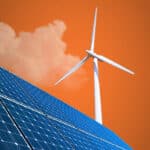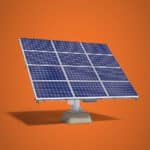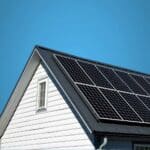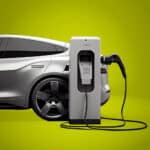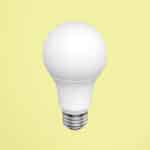At Gen180, we’ve been reading, hearing, and receiving more questions about ways electric vehicles (EVs) can serve as back up electricity generation for a home or community. We spoke with two people using their EVs for this purpose. Ben, an EV owner and ambassador, shares his personal experience using his EV to power small and large appliances. David, founder of Charlottesville-based Fermata Energy and an EV owner, explains how using EVs for bi-directional charging can play an important role in grid stability, while also generating income for EV owners.
Gen180: What’s your EV background, Ben?
Ben: I bought my first EV in 2022, a Polestar 2, and drove it for two and a half years putting 76,000 miles on it. Last year, I traded it in for a Ford F-150 Lightning. Prior to that, I’d driven a Chevy Bolt for my job in South Carolina, this was the first EV in their fleet. I and three of my colleagues at the time went on to purchase EVs for our personal vehicles.
Gen180: What is bi-directional charging, and can all EVs do this?
Ben: Bi-directional, or two way charging, means that power or electricity can both go into an EV and also come out of an EV. Not all EVs are bi-directional – they can all receive electricity, but they can’t all provide outgoing electricity. The Nissan Leaf was the original EV to offer bi-directional charging. Today, a variety of EVs offer some form of electricity output (V2H/V2L/V2G) including the Hyundai Ioniq 5, Ford F-150 Lightning, Volkswagen ID. 4, Polestar 3, Kia’s EV6 and Niro. This isn’t the whole list and it’s growing, so if you are interested in an EV with the ability to export power, explore the manufacturer’s website for more information.
Gen180: What is V2X?
Ben: V2X is technically taking electricity from your vehicle battery and exporting it to something else. Vehicle (V) to (2) whatever it is you are charging (X). Within V2X, there are more specific categories. The main areas for individual EV owners include:
- V2L: Vehicle to Load – plug an appliance directly into your vehicle’s outlet
- V2H: Vehicle to Home – If your EV offers bi-directional charging, you can plug your vehicle in as a power source to your home. Instead of using a gas generator – you use power stored in your vehicle to power your home.
- V2V: Vehicle to Vehicle – If you have two EVs and want to transfer electricity from one to the other.
Gen180: How have you personally used your electric vehicle?
Ben: I live in Nelson County, Virginia near Shenandoah National Park and the George Washington National Forest. I love being outside and going camping. My EV is like a mobile power station (V2L) where I can plug in lights, a grill, and a small refrigerator. It’s great to be able to pick up supplies at the grocery store, including ice cream, and have them fresh at the campsite. I haven’t fully gone through the process to prepare for a power outage yet, but in 2025 I’ll work with an electrician to install an outlet to plug the F-150 into my home with a 240V cable, which will allow me to power appliances in the home (V2H). When the Ford Lighting is fully charged, it can hold up to 131 kilowatt hours (kWh) or about 3-4 days of electricity for key appliances in the home.

Photos: Ben cooking and lighting up his campsite with his Ford F-150 Lightning.
Gen180: What should folks consider if they want to buy an EV and utilize exporting power?
Ben:
- Know which EVs offer this and what their battery/charging capacity is by looking at the manufacturer’s website.
- Research how much energy/capacity your important home appliances take.
- Understand what you’re doing, then plug in and enjoy!
Gen180: Is there anything else people should remember?
Ben: On the resilience side – just as you would charge your phone or laptop before a storm or possible weather outage, make sure your vehicle is fully charged ahead of time.
Gen180: David, tell us about your EV background and what you do.
David: I bought my first EV in 2007, a Ford Ranger EV made in 2000, I still have it today. In 2010 I founded Charlottesville, VA-based Fermata Energy to accelerate the transition for the driving public to electric vehicles and to enable the transition to renewables for generating electric power by providing huge amounts of energy storage from cars..
Gen180: What should folks consider if they want to buy an EV that can also provide electricity?
David: It’s true that some EVs can provide backup power. However, it’s relatively rare that home power is out or that the grid goes down. Traditionally, cars have been used for a single use: to get you from point A to point B. Electric vehicles, in addition to being a transportation option, they are more efficient, fun to drive, zero emission, and also have a large battery that provides a reservoir of stored energy that can be sold back to the grid to make money when the car is parked. Perhaps more important, the energy discharged from V2X vehicles supports the transition to renewables and provides grid stability.
Gen180: Tell us more about how EVs can be used and thought of as part of the larger system of grid stability.
David: EVs have a relatively large, mobile battery system. Bi-directional charging can not only provide a home or business with backup energy, it can also send some of that energy over to the grid (Vehicle to Grid) when there is high demand. Utilities can request access to extra energy – and access it on demand. This allows the EV to be used while it’s parked and it can also provide income to the owner. On average, an EV can generate up to $4,000-5,000 to the owner each year. In some markets, that can be even higher.
Gen180: Are individuals who own EVs able to sign up for this right now?
David: At the moment, most of Fermata Energy’s work is for commercial bi-directional charging. However, there are several bi-directional chargers for residential homes that will be available in North America this year.
Gen180: Is there anything else people should know and consider in the V2X/V2G space?
David: Battery health in EVs is a concern for most people – from new EV buyers to those considering the V2X space. Batteries have come a long way and there have been some recent and promising studies coming out of the University of Warwick that show how V2X, when managed properly, can actually extend battery life. If V2X is properly done, I don’t think people need to be concerned about the health of the batteries. In fact, Nissan has already agreed to maintain the battery warranty for groups like Fermata Energy who are doing this properly. Lastly, I believe that the biggest potential value add for EV is their role in supporting grid stability and the larger transition to renewable energy. In the future, I think that all EVs will be bi-directional.
